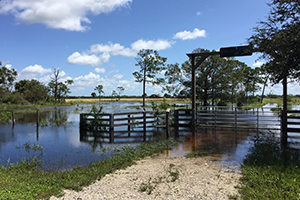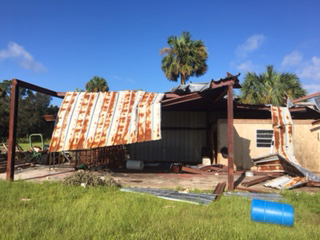Hurricane Irma hit Florida extremely hard. Its fierce winds, rains and storm surge devastated people’s lives and communities. Images of homes reduced to rubble filled our television screens, our Facebook feeds and the front pages of our newspapers.
But there is another underlying story that has not received as high profile coverage. Hurricane Irma’s impact on Florida’s agriculture and natural resources producers is at a devastating level. Preliminary assessments range from 50-90 percent loss to our citrus production in some areas, to similar levels of loss to vegetable and fruit production, to complete losses for some producers. The ornamental industry both in southwest Florida and all the way up to Volusia County were hit especially hard and will most likely miss out on the important fall market cycle. Dairy producers in South Florida faced unprecedented losses to structures, facilities and animals.
Sugar cane has been blown over and lodged. Even if tomato growers can get a field planted, there is not enough time to use appropriate management strategies, which then compromises their chance of making a successful crop insurance claim.
Our coastal communities have suffered damage to the fish and shellfish industries with lost fishing boats. The $150 million lobster industry along the Keys suffered a loss with 450,000 lobster traps damaged, misplaced or completely lost.
UF/IFAS Extension agents were out assessing damage in their counties less than 24 hours after the storm swept through. We just completed a more thorough assessment of the damage across agriculture and in our coastal communities that has been shared with the highest level state and national agricultural decision makers.
Our own UF/IFAS Extension offices were damaged, particularly in Collier County. The roof was ripped off the building and there was extensive water damage. Staff are now working to a limited extent in part of their current office and in other temporary offices. The faculty and staff are resilient and working hard to address the needs of Collier County residents. Highlands County staff are still wondering where they will end up working as their offices were used as a special needs shelter and now may be used by FEMA officials.
For many of us, life has returned to normal. The only reminder of Hurricane Irma may be the piles of tree limbs still on the curb waiting to be carted away. But we must not forget the long recovery ahead for our agriculture and natural resources families. Their struggles are often invisible to the general public but very evident to our faculty and staff in these rural communities.
For the majority of Floridians, agriculture is hidden — something done in counties that they never drive through and know little about. But we all love the fresh produce and reliable income provided by this state’s second largest industry. We need to remind our neighbors of the agriculture and natural resources families that are still suffering and have a very long recovery ahead. We all are in this together and it is only together that we will successfully recover and build a stronger Florida.
While some of us are returning to normal operations faster than others, all of us will learn from the experience. There are things we can and should do differently, if there is another similar storm. Regardless of the extent of the damage done to our communities, we are all learning lessons that will be helpful now as well as in the future.
One of the most valuable lessons we have learned is the important role of science-based information during a crisis. Moreover, a valuable lesson learned is the important role that Extension plays on the local level throughout the state. Through Extension, we are your local responders in times of need, such as with disasters like Hurricane Irma. Thank you for all that you have done and continue to do to help our Florida neighbors recover from this storm.
Follow me on Twitter @nplace01.
 0
0



